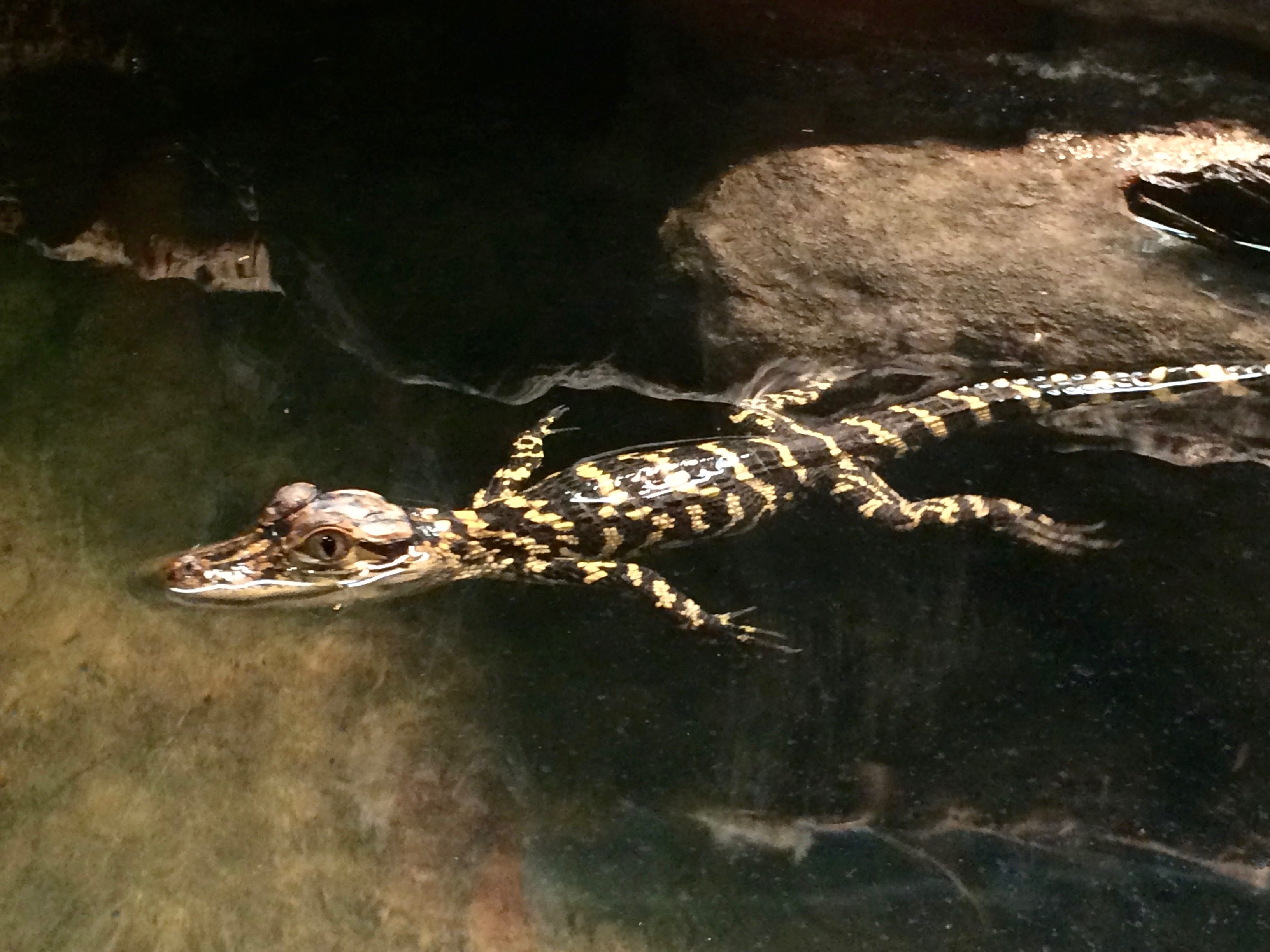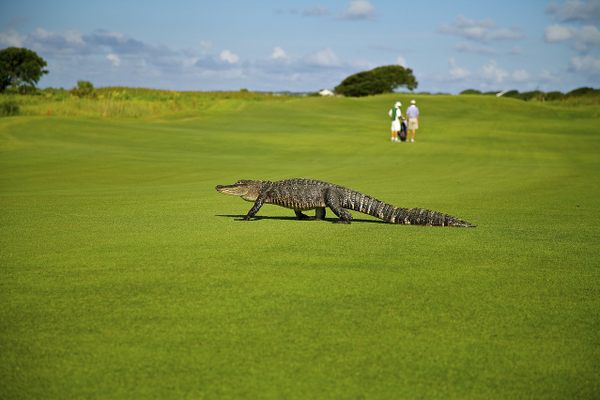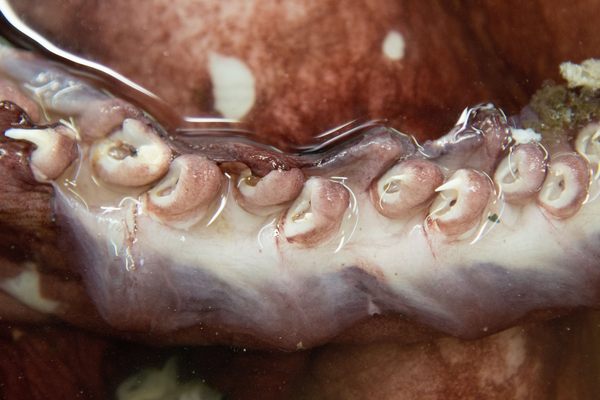How to Travel Safely With a Crocodile
A professional reptile transporter breaks it down.
Two live Siamese crocodiles (Crocodylus siamensis) at the new AMNH Crocs exhibit. (Photo: © AMNH/C. Chesek)
It was in the middle of the night, cruising along the highway somewhere in the Carolinas, that Chad Peeling and his companions noticed something wasn’t quite right with their trailer. They had been rotating drivers on their road trip from Florida to Pennsylvania, but this was the first time they’d noticed any irregular movement. They pulled off at the nearest gas station.
When they went back to take a look, they found that the inside of the trailer had been utterly demolished. One of their massive alligators had gotten impatient, flexed his armor-clad limbs, and burst out of his crate, splintering it into toothpicks.

This 15-foot saltwater crocodile would probably be a challenge for UPS or your Subaru. (Photo: Molly Ebersold of the St. Augustine Alligator Farm/Public Domain)
They decided their best move was to just keep on driving. “It was a real nail-biter,” says Peeling, remembering the incident, which took place 20 years back. Luckily, they made it to Clyde Peeling’s Reptiland without further incident. “It taught us two important lessons: We want to keep them very tightly confined during shipping, and obviously, the crating has to be built to accommodate their strength.”
Peeling is the Operations Manager at Reptiland, a specialized zoo in Allenwood, Pennsylvania. He helps send crocs and gators, big and small, on journeys short and long, by land and air. He’s packed up an 11-foot-plus American alligator that weighed over 600 pounds and sent crocs coast-to-coast across the U.S.

A Central African slender-snouted crocodile. (Photo: © AMNH/C. Chesek)
Reptiland’s crocodilians hit the road or the airplane runway en route to zoos, museum exhibits, and romantic rendezvous—also known as breeding visits. (“Crocodilian” is a term that covers crocodiles, alligators, caimans, and gharial―not to be confused with crocodylomorphs, an umbrella term for today’s crocodilians and their extinct brethren.)
The company’s most recent transport involved getting a small squadron of crocodiles from Pennsylvania right into the heart of Manhattan, for the newest exhibit at the American Museum of Natural History, Crocs: Ancient Predators in a Modern World. A couple of weeks ago, five adorable American alligator hatchlings, a Siamese crocodile, two West African dwarf crocodiles, and a Central African slender-snouted crocodile arrived safely to the Upper East Side.
“We often compare it to moving tissues for organ transplants,” says Peeling. “We have to be very careful of the animal’s needs—we move fast to limit stress.”

A baby crocodylomorph. (Photo: Tao Tao Holmes/Atlas Obscura)
Crocodiles, says Peeling, are very sensitive to temperature―cool temperatures in particular. The first thing Reptiland did as part of their loan to the Crocs exhibit was to send a crew to set up the crocodile habitats, stabilize their temperature, and check the water quality before the animals arrived, were unloaded and transferred into the exhibits.
On the day of their trip, the crocs were packed up early in the morning and driven to New York City in a climate-controlled van. Special crates are built for each individual species, since the crate must be sized to fit the animal so it doesn’t move around too much and hurt itself. The careful dimensions and inside padding keep the croc in the same position for the entirety of its trip.
As for air transports, if a private airplane is used, then climate control is right at the staff’s fingertips. But private planes only work for shorter distances; when it comes to swapping coasts or venturing abroad, Reptiland and others like it rely on commercial aircraft. Major airlines, says Peeling, are willing to ship animals like crocodilians as long as they are packed per regulation―and there are some very, very specific regulations. The crocs fly cargo, in insulated crates designed to regulate temperature. But weather is still a key factor, especially in the cold season if they’re shipping tropical animals, and staff on the ground keep a very close eye.

This guy (a five-foot-long West African dwarf crocodile) arrived at the Museum of Natural History via the highway. (Photo: © AMNH/C. Chesek)
As for inflight snacks, there’s no need, says Peeling. In fact, it’s important not to feed them right before they ship. As it is, crocs only eat once every couple of weeks.
Once the croc arrives via van or trailer to its destination, it still has to get from the vehicle into its new enclosure. For smaller animals, a team of people can simply carry the crate where it needs to go and transfer the animals into its carefully prepared habitat; once the crate is opened, the croc will often walk right in. However, bigger crocs, of the 600- to 800-pound variety, require heavy equipment such as forklifts, cranes, and backhoes, which lift the cargo net or crate from the trailer and then lower the animal into the pool. These heftier chaps often have their jaws secured with surgical tape for safety during transport.
All this upheaval can be stressful for the humans involved, but the reptiles being shifted don’t suffer separation anxiety or get sad about leaving home. “Crocs are very complex animals, way more intelligent and sensitive than I think they’re given credit for,” says Peeling. But they aren’t social in that way―they don’t show attachment to each other, except when they come together for breeding or with their young. “In fact, a much bigger factor is making sure they are separated when they need to be, because they are famous for fighting over territory.”





























Follow us on Twitter to get the latest on the world's hidden wonders.
Like us on Facebook to get the latest on the world's hidden wonders.
Follow us on Twitter Like us on Facebook